Low-E glass is a big hit in modern buildings. It saves energy and keeps spaces cozy. This article explains what Low-E glass is, its upsides and downsides, and if it’s good for your building. We’ll also check out GlasVue’s Low-E glass products and how they work in real projects.
Introduction to Low-E Glass
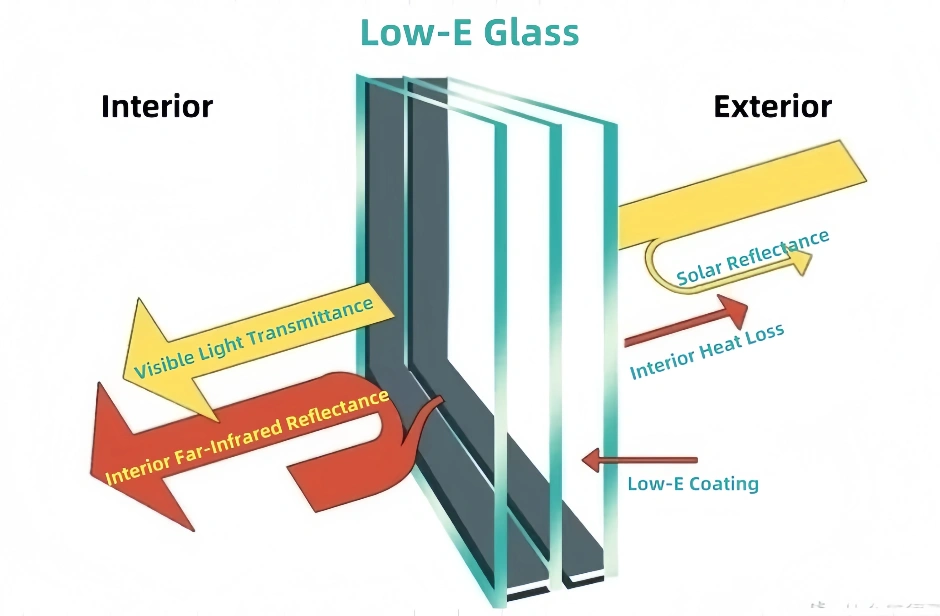
The Definition of Low-E Glass
Low-E glass is a special kind of glass with a thin coating. This coating stops heat from moving too much. In winter, it traps warmth inside. In summer, it keeps hot air out. The coating comes in two types: online and offline. These show how the coating gets added when the glass is made.
Types of Low-E Coatings:
- Online Low-E: This coating is applied directly to the glass while it is still in a high-temperature, softened state during manufacturing. The film layer is highly stable, resistant to heat, and can be used as monolithic glass. It can also undergo further processing (e.g., tempering or heat bending) and is more durable than standard coated glass.
- Offline Low-E: This coating is applied pre-tempering using vacuum magnetron sputtering technology to deposit a precise metallic film. It offers superior energy efficiency but has a more delicate film layer, requiring protection via lamination or insulating glass units (IGUs). It is not suitable for direct exposure to the environment.
Low-E glass also comes in different light levels:
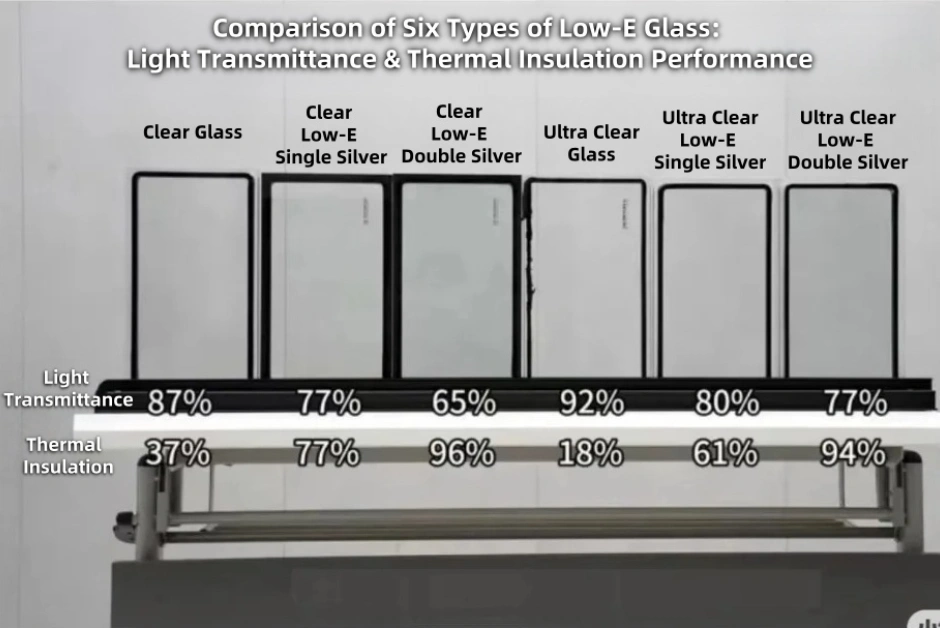
- High Transmittance (HT): These let in lots of sunlight but still save energy.
- Medium Transmittance (MT): These mix light and heat control nicely.
- Low Transmittance (LT): These block more sun, giving awesome insulation and privacy.
Why It Matters for Buildings
Low-E glass is essential for saving energy and protecting the environment. Its smart design keeps heat inside when it’s cold. In hot weather, it stops extra heat from entering. This means buildings need less heating and air conditioning. It also helps structures follow strict eco-friendly rules, like LEED (Leadership in Energy and Environmental Design).
Advantages of Low-E Glass
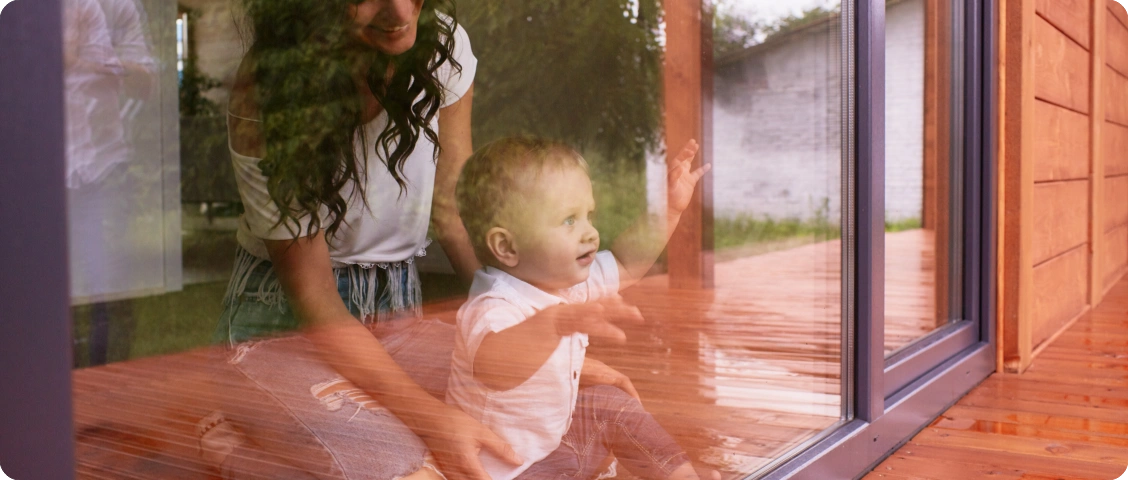
Saving Energy Like a Pro
Low-E glass excels at lowering energy consumption.
Reduced Heating and Cooling Costs
It keeps indoor temperatures just right. In winter, it stops warmth from sneaking out. In summer, it blocks hot air from coming in. This means you use heaters and air conditioners less. And that cuts your energy bills, which is awesome for homes and businesses.
Top-Notch Insulation:
Compared to plain glass, Low-E glass is way better at insulating. It’s special coating keeps heat where you need it. This is really helpful in super hot or freezing places. It makes your space comfy and saves energy.
Blocking Harmful UV Rays
Low-E glass effectively blocks the majority of ultraviolet (UV) radiation, with certain configurations capable of blocking approximately 90% to 99% of UV rays.
Keeping UV Rays Out:
UV rays can fade your furniture, carpets, and pictures. Low-E glass blocks most ultraviolet (UV) rays but does not completely eliminate them, significantly slowing down the fading of home furnishings.
Protects Your Stuff
By stopping UV rays, Low-E glass keeps your furniture and decor looking fresh and colorful for a long time.
Controls Condensation
Condensation happens when warm indoor air hits cold glass, especially in winter.
Fewer Wet Windows
Low-E glass cuts down heat moving between inside and outside. This reduces condensation on windows.
Stops Mold Growth
By reducing the glass condensation phenomenon, the glass can remain dry, thus reducing problems such as mold and odors caused by moisture. It’s perfect for humid areas.
Flexible Light Options
Low-E glass comes with different light-passing levels. You can pick the right one to balance daylight and heat control based on your building’s needs.
Light Choices
You can control how much sunlight comes in. Choose high, medium, or low light options to match your building perfectly. This helps balance natural light with energy savings.
Dual Benefits
Low-E glass is great because it lets in helpful daylight while controlling heat. It’s perfect for buildings that want lots of light but need to manage temperature. It keeps spaces cool in summer and warm in winter.
Disadvantages and Things to Consider
Higher Initial Cost
Low-E glass saves money over time, but it costs more upfront.
Pricier Than Regular Glass
Making Low-E glass, especially offline coatings, is expensive. This can be tough for tight budgets.
Long-Term Savings
Even though it’s costly at first, Low-E glass cuts energy bills. Over time, you save on heating and cooling. It’s a smart choice in the long run.
Impact on Sunlight
Low-E glass can affect how much light comes in.
Less Natural Light
Some Low-E glass reduces sunlight. This might not work for rooms needing lots of light. But you can choose different types to get the right light level.
Balancing Light and Energy
Picking the right Low-E glass means finding a balance. You want to save energy but keep enough daylight. High-transmittance Low-E glass is great for buildings with big windows that need light.
GlasVue’s Low-E Glass Solutions
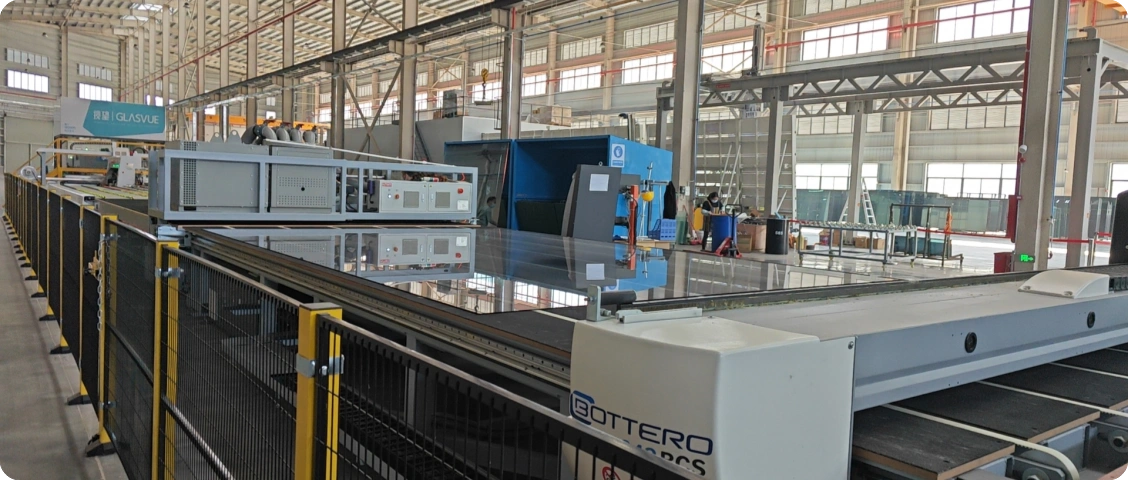
Product Overview
GlasVue makes a variety of Low-E glass products for homes and large buildings.
About GlasVue’s Low-E Glass
GlasVue produces top-notch Low-E glass to save energy, keep spaces comfy, and block UV rays.
Features and Specs
Our Low-E glass offers excellent insulation, UV protection, and condensation control. It’s clear and suits all kinds of buildings.
Here’s a table showing GlasVue’s Low-E glass options:
| Type | No. | Reflected Color | Visible Light (%) | Solar Energy (%) | U-Value (W/m²·K) | Shading Coefficient | Solar Heat Gain Coefficient (SHGC) | Relative Heat Gain (W/㎡) |
| Single Silver (Low-E)
6+12A+6 |
6XETS0150+12A+6C | Silver Grey | 44 | 27 | 1.74 | 0.39 | 0.34 | 258 |
| 6XETB0150+12A+6C | Blue Grey | 44 | 26 | 1.78 | 0.39 | 0.34 | 257 | |
| 6XETS0160+12A+6C | Silver Grey | 53 | 32 | 1.74 | 0.45 | 0.39 | 297 | |
| 6XETB0160+12A+6C | Blue | 53 | 33 | 1.78 | 0.46 | 0.40 | 306 | |
| 6XETB0170+12A+6C | Blue | 64 | 39 | 1.81 | 0.54 | 0.47 | 354 | |
| 6XETN0180+12A+6C | Clear | 71 | 48 | 1.80 | 0.64 | 0.56 | 418 |
Real-World Applications
Case Studies and Success Stories
Australian Villa at 20 Coolawin Road:
For a luxurious home in Australia, GlasVue’s Low-E glass was installed. The setup was 6+1.14PVB+6+12A argon+6Low-E. It saved energy, reduced noise, and cut energy costs by over 30%. This proves Low-E glass makes homes cozy and budget-friendly.
Performance and Green Impact
Energy Performance Ratings:
Our Low-E glass performs well in saving energy. It lowers heating and cooling costs significantly.
Eco-Friendly Certifications:
GlasVue’s Low-E glass meets green building standards. It helps make buildings kinder to the environment.
Is Low-E Glass Right for Your Building?
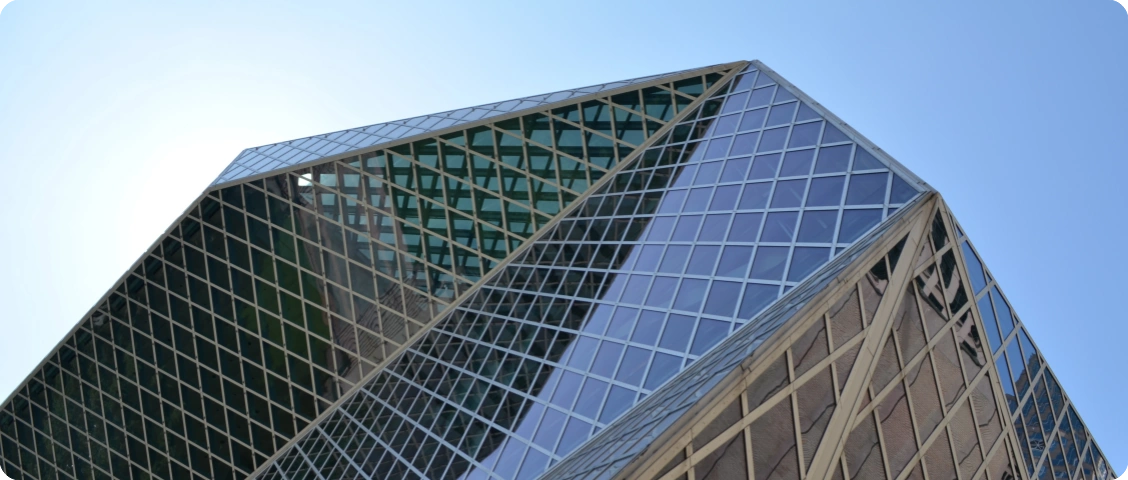
Things to Think About
Weather Impacts
In very hot or cold areas, Low-E glass is a huge help. It keeps indoor temperatures steady. This saves energy big time.
Window Direction
The way your windows face matters. It affects how Low-E glass works. GlasVue’s experts can pick the best setup for your building.
Budget and Long-Term Plans
Low-E glass costs more at the start. But it saves money later with lower energy bills. Think about your budget and future goals.
Expert Tips
Talk to Experts
Work with pros to choose the best Low-E glass. They’ll check your building and suggest what fits.
Check Energy Use
Do an energy audit. It shows how Low-E glass can save you money. You’ll see the benefits clearly.
Conclusion
Final Thoughts
Low-E glass is fantastic for saving energy, blocking UV rays, and keeping temperatures steady. But you need to consider the upfront cost and light impact. GlasVue’s Low-E glass is a great choice for many buildings.
FAQs
Q1: How do online and offline Low-E glass differ?
A: Online Low-E Glass (Hard-Coat Low-E):
This layer is added during glass-making at high heat. It’s strong and can handle more processing. You can use it as a single pane or temper it. The coating stays tough through extra steps.
Offline Low-E Glass (Soft-Coat Low-E):
This is made with a special vacuum method for a thin coatingCompared with online low-e glass, its energy efficiency is stronger, compared with online low-e glass, its energy efficiency is stronger. It needs to be sealed in insulated glass units to avoid damage.
Q2: Does Low-E glass reduce light?
A: Low-E glass slightly cuts down visible light. But the effect is small. You can pick high-, medium-, or low-transmittance options based on your light needs. This balances energy savings with natural light.
Q3: Is Low-E glass good for all weather?
A: Yes, it works great in hot or cold places. It keeps warmth in during winter and blocks heat in summer. It’s perfect for any climate.



